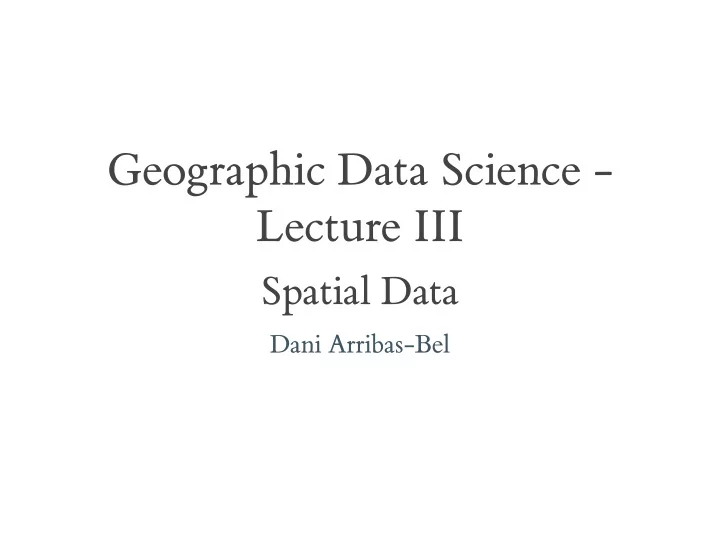

Geographic Data Science - Lecture III Spatial Data Dani Arribas-Bel
“Day 1” Introduced the (geo-)data revolution What is it? Why now? The need of (geo-)data science to make sense of it all
Today Types of (geo-)data: refresher Traditional and new sources of spatial data New ways for traditional approaches
Representing the World Digitally
GIS Data Models Traditionally, geographic information is represented as: Vector finite set of entities (shapes/geometries) Raster images encoding surfaces (values, colours, etc.)
Vector
Raster
Good old spatial data
Good old spatial data [ source ] The US Census puts every American on the map The US Census puts every American on the map Watch later Watch later Share Share
Good old spatial data (+) Traditionally, datasets used in the (social) sciences are: Collected for the purpose –> carefully designed Detailed in information (“ …rich profiles and portraits of the country… ”) High quality
Good old spatial data (-) But also: Massive enterprises (" …every single person… ) –> costly But coarse in resolution (to preserve pricacy they need to be aggregated) Slow : the more detailed, the less frequent they are available
Examples Decenial census (and census geographies) Longitudinal surveys Customly collected surveys, interviews, etc. Economic indicators …
New sources of (spatial) data
New sources of (spatial) data Tied into the (geo-)data revolution, new sources are appearing that are: Accidental –> created for different purposes but available for analysis as a side effect Very diverse in nature, resolution, and quality but, potentially, much more detailed in both space and time Different ways to categorise them…
Lazer & Radford (2017) Digital life: digital actions (Twitter, Facebook, WikiPedia…) Digital traces: record of digital actions (CDRs, metadata…) Digitalised life: nonintrinsically digital life in digital form (Government records, web…)
Arribas-Bel (2014) Three levels, based on how they originate: Bottom up: “Citizens as sensors” Intermediate: Digital businesses/businesses going digital Top down: Open Government Data
Opportunities (Lazer & Radford, 2017) Massive, passive Nowcasting Data on social systems Natural and field experiments (“always-on” observatory of human behaviour) Making big data small
Challenges (Arribas-Bel, 2014) Bias Technical barriers Methodological “mismatch”
Old/New, raster/vector…
Old/New, raster/vector… Traditional approaches to represent the world in a computer are blending thanks to new forms of data Keep an open mind to tools, approaches, and methods
Geographic Data Science’19 by Dani Arribas-Bel is licensed under a Creative Commons Attribution- ShareAlike 4.0 International License .
Recommend
More recommend